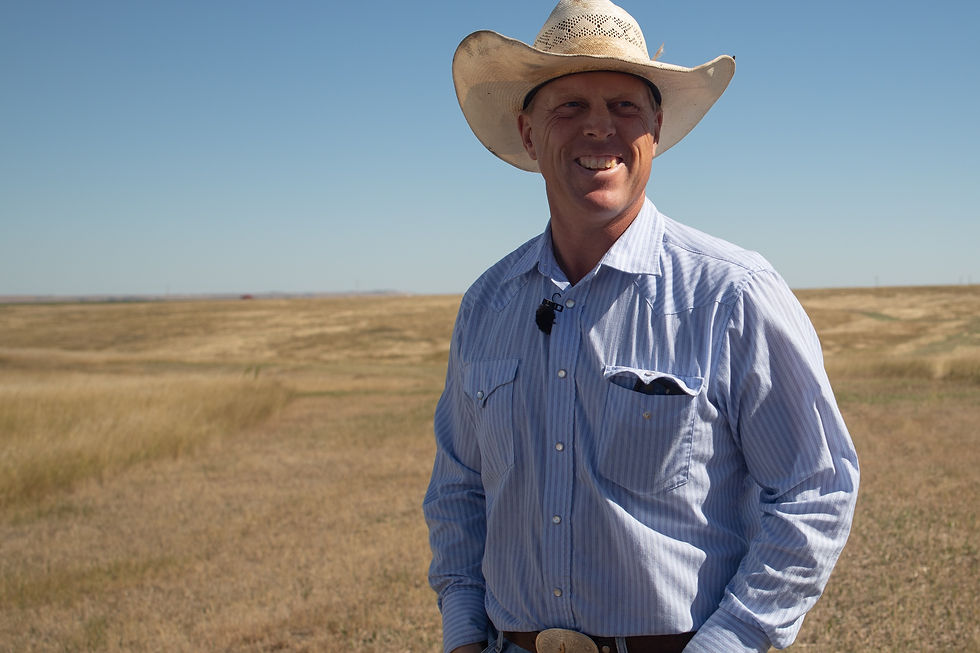Justin Thompson, SD Rancher, Explains the Unexpected Benefits of Adaptive Grazing Strategies
- Cassidy Spencer
- Apr 19, 2023
- 4 min read
Updated: Jul 7, 2023
Cassidy Spencer, Growing Resilience Staff Writer
Justin was raised on the ranch and now runs two ranches, one owned and one leased, one West of Mobridge, SD, and the other about 20 miles further West. In a recent episode of the Growing Resilience podcast, Justin spoke with Buz Kloot, Emily Helms, and Ryan Beer on the development of new grazing strategies on his property.

In 2018, Justin found himself in a tough position. He grew up with an intimate, home-grown understanding of ranch management, observing the importance and success of traditional grazing techniques. In his adult life, he started going to Rangeland schools, one or two a year. “You come back from those schools so excited, that you want to implement everything instantly” says Thompson.
Over the subsequent years, he observed consistent improvements, every year adjusting something; adding fence, increasing, or decreasing cattle numbers, adding water lines (with the help of program funding and technical advice.) In time, he saw his pastures grazed astonishingly evenly. He implemented rotational grazing, stockpiling grass for dry years and allowing pastures intermittent rest. In 2018, the land experienced heavy snow.
Following this snow, he began to experience his first crisis with invasive cool-season grasses, primarily Kentucky bluegrass, with thick, dense root systems that tend to choke out native grassland. Smooth brome and crested wheatgrass (both invasive cool-season grasses) started creeping in from ditches, overcoming his western wheatgrass. He noticed the invasive grasses thriving in the conditions he had designed for his native grassland. But then he noticed unexpected progress in unforeseen conditions.
In four locations on his rangeland, the soil had been disturbed unexpectedly. In one instance, the power company had to disturb the land in order to take down a power line and install underground lines. In another, there was a small patch of land on a hill where he gave fall shots to a herd- a lot of hoofs in a small area.
In these swaths of land of unexpected soil disturbance, he noticed his western wheatgrass growing more uninhibited than elsewhere on the land. He was reluctant to draw any conclusions, however, as he’d seen soil be destroyed in the past by not being allowed enough rest; “I have seen soil disturbed in branding corrals so much that only weeds grew in it, and that doesn't look quite right either, so timing has something to do with it also.”
In this moment, it became clear to him that, while his upbringing and technical education in ranch management offered him imperative encouragement, context, and resources, it would not be enough to extend and enhance the livelihood of his pasture. He learned that intermittent disturbance breaks up the invasive grass’ thatch of roots near the surface, allowing other things to break through.
How do we adaptively manage our way to native grass rangeland?
While resting the soil is important, Justin learned through this experience that simply avoiding disturbance is not the pinnacle of soil health. He subdivided the land into smaller pastures with fiberglass posts and high-tensile wire, allowing for more collected hoof density in one patch of land at a time and running water lines out to the subdivided pastures. He kept some yearlings, rather than selling them, and is incorporating a rotation of more intentional, pointed disturbance of small plots of his land. As Ryan Beer, Dakota rangeland manager, notes, “It is a balancing act. We want to make sure we have enough litter to protect the soil, but not so much that it starts changing the plant community. More intensive grazing at different times. A lot of people in this area don’t like the idea of fire, but maybe some fire to reduce that thatch layer. Basically, we created [the problem] ourselves by being too good of managers and leaving too much grass.” Adaptive land management offers solutions to ranchers who inevitably find that there is not one grazing practice that can be prescribed to all land– that some organism will find a niche in the formula. As Buz notes– “Mother nature will always have the last word.”.
Ranchers may push back against these adaptive strategies as prioritizing calf health and economic safety are important. And while there are many priorities to the rancher other than grass management, Ryan notes that the grassland is where ranch livelihood starts. Ranchers may have practical difficulties implementing adaptive strategies– maybe they do not own the land they farm, maybe neighboring land limits the extent to which they are free to alter their herding strategies, maybe they simply do not have the resources to unseat and alter their past tactics with immediacy. Justin reminds us that adaptive grazing is rooted in the practice of simply observing your own land. Every grazing plan must be highly adapted to the land, territory, and livelihood of the rancher as well, and need not be overly complex, only suited to nature’s nuance. There is no one size fits all, and over time, Justin hopes to be one of many ranchers gaining intimacy with one’s own land and adapting their ranching practice to its location, its topography, the precious balance of its specific conditions.
For more information on Justin, on Cool Season Invasive Grasses and on Adaptive Management please follow the links below.
Podcast with Justin: https://www.growingresiliencesd.com/podcasts/episode/2bf73451/47-sd-ranchers-unique-approach-to-manage-cool-season-invasives
NDSU Perennial Cool-Season Invasive Grasses Workshop: https://www.growingresiliencesd.com/post/notes-on-the-perennial-cool-season-invasive-grasses-of-the-northern-great-plains-workshop
Dr. Allen Williams talk on Adaptive Grazing Management: https://pastureproject.org/wp-content/uploads/2017/09/IL%20Grazing%20Demo%20Field%20Day_08.25.17.pdf
____________________________________________________________________
Visit these “Growing Resilience Through Our Soils” information pages:
1. Podcast page for drought planning fact sheets, Q&As, news, podcasts and more.
2. Video page to watch videos of other ranchers’ journeys toward improved rangeland/pasture.
3.Follow Growing Resilience on social media:
4. Our homepage: www.growingresiliencesd.com





Comments